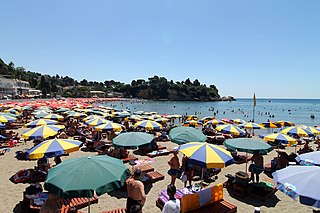Related Research Articles

Ulcinj is a town in the Coastal region of Montenegro and the capital of Ulcinj Municipality. It has an urban population of 11,488.

Ulcinj Municipality is the southernmost municipality of Montenegro, bordered by Albania to the east, Bar Municipality to the north and Adriatic Sea to the south and the west. It has an area of 255 km², and a population of 19,921 as of the 2011 census. Its seat is the town of Ulcinj.

Islam in Montenegro refers to adherents, communities and religious institutions of Islam in Montenegro. It is the second largest religion in the country, after Christianity. According to the 2011 census, Montenegro's 118,477 Muslims make up 20% of the total population. Montenegro's Muslims belong mostly to the Sunni branch. According to the estimate by the Pew Research Center, Muslims have a population of 130,000 (20.3%) as of 2020.

Ada Bojana is an island in the Ulcinj Municipality in Montenegro. The name Ada means river island in Montenegrin.
Montenegro is one of the fastest-growing tourist destinations. In 2007, over a million tourists visited Montenegro, making some 7.3 million overnight stays. This accounted for some 480 million euros in tourism revenue in 2007. In 2015, tourism realised over 1.7 million arrivals, with a further increase in 2016. In the same year, the coastal town of Kotor was named the best city to visit by Lonely Planet, whereas the country itself is continuously included in touristic top lists. With a total of 1.8 million visitors in 2016, the nation became the 36th most popular country to travel to in Europe. Montenegro was further visited by over 2 million tourists in 2017. The Government aims to attract greenfield investments, which should make best use of undeveloped parts of the coast, such as Jaz Beach, Velika Plaža, Ada Bojana and Buljarica.
Television in Montenegro was first introduced in 1956. This is a list of television channels that broadcast in Montenegro.

The Hotel Mediteran Ulcinj, located in the coastal town of Ulcinj in Montenegro, is one of the first privatization deals completed by the new nation of Montenegro. The hotel was acquired by in July 2005 through the Commerce Court of Podgorica. The hotel is considered a vital property as part of national economic development.
Ladies Beach is a beach in Ulcinj, Montenegro. It is one of many beaches in Montenegro's South Coast with a special liking amongst the visitors to the region, as well as the local residents.
Reč is a small town in the municipality of Ulcinj, southeastern Montenegro.Reč is mentioned in 1413 in the Scutarias taxable income part of the Albanian (arbanas) katun of Gjon Kereçi In recent times, many locals have migrated, notably to the United States. The area is a prime site for agricultural land, hunting, and fishing.

The Sailors' Mosque is an important landmark in Ulcinj, Montenegro that once served as a lighthouse.

Pasha's Mosque is one of six mosques in the city of Ulcinj, in Montenegro.

The Ulcinj Castle or Ulcinj Old Town is an ancient castle and neighborhood in Ulcinj, Montenegro. Today it is mostly inhabited by Albanians, it was built by the Illyrians on a small peninsula at the right side of the Pristan Gulf, which is part of the Adriatic Sea. Today, oldest remains are the Cyclopean Wall. The castle has been restored many times since it was first built although major changes were made by the Byzantines, Serbs, Venetians, and Ottomans. The modern city of Ulcinj was built outside of this castle.

The Church-Mosque of Ulcinj, also called Imperial Mosque, Halil Skura Mosque, Kalaja Mosque or Church of St. Maria is a former church and mosque located in Ulcinj, Montenegro.

The Lami Mosque is one of the six mosques in Ulcinj, Montenegro.
The Kryepazari Mosque, also called Majapazari Mosque is one of the six mosques in Ulcinj. It was built by Nuradin-Beg from Ulcinj in 1749. It was destroyed in the earthquake in 1979, and 16 years later it was renewed by the donations of the local people. The Friday Khutbah is given in Arabic and Albanian. To the complex of this mosque also belong the main office of the Islamic religious community of Ulcinj, a library and a kindergarten.

The Namazgjahu Mosque, also called Big Mosque is one of the six mosques in Ulcinj, Montenegro, the biggest one.

Mala Plaža also called City Beach is a beach in Ulcinj Municipality, Montenegro.

The Clock Tower of Ulcinj, was built in Ulcinj, Montenegro in 1754 during the Ottoman Empire's rule over the city, with the help of donations made by the citizens of Ulcinj. The name comes from the Turkish Saat Kulesi which literally means "Clock Tower" in English.
Stadion Olympic is a multi-use stadium in Ulcinj, Montenegro. Mostly used for football matches, it has a capacity of 1,500 seats.

Museum of Local History in Ulcinj or simply Museum of Ulcinj is a local museum located in Kalaja, part of Ulcinj, Montenegro.
References
- ↑ Vjerski objekti u Ulcinju, Visit Montenegro
41°55′50.8″N19°12′41.7″E / 41.930778°N 19.211583°E

